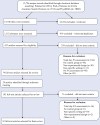Specific Strategies for Promotion of Physical Activity in Kids-Which Ones Work? A Systematic Review of the Literature
- PMID: 30202382
- PMCID: PMC6125022
- DOI: 10.1177/1559827615616381
Specific Strategies for Promotion of Physical Activity in Kids-Which Ones Work? A Systematic Review of the Literature
Abstract
The purpose of this systematic review was to summarize and evaluate the impact of physical activity (PA) interventions that were implemented in specific school settings on children's PA in those settings. Four research databases were searched to identify PA interventions. Of the 13 706 articles identified, 1352 abstracts were screened and 32 intervention studies were reviewed. Five intervention settings were identified (active travel, after school, classroom, physical education, and recess). Among these settings, a greater proportion of positive findings (ie, significant increase in PA) were found in the classroom (75%) and active travel (67%) settings. Additionally, a higher proportion of interventions implemented in these settings were of high methodological quality (active travel [33%] and classroom [33%]). These findings indicate that interventions in active travel and classrooms settings positively influence youth PA. Importantly, as evidenced in this review, evaluating intervention effects in the targeted setting may provide unique information for future researchers to consider when developing school-based multicomponent PA interventions.
Keywords: intervention; physical activity; school; youth.
Conflict of interest statement
Declaration of Conflicting Interests: The author(s) declared no potential conflicts of interest with respect to the research, authorship, and/or publication of this article.
Figures
Similar articles
-
The evidence for the impact of policy on physical activity outcomes within the school setting: A systematic review.J Sport Health Sci. 2021 May;10(3):263-276. doi: 10.1016/j.jshs.2021.01.006. Epub 2021 Jan 19. J Sport Health Sci. 2021. PMID: 33482424 Free PMC article.
-
Understanding the Benefits of Brief Classroom-Based Physical Activity Interventions on Primary School-Aged Children's Enjoyment and Subjective Wellbeing: A Systematic Review.J Sch Health. 2022 Sep;92(9):916-932. doi: 10.1111/josh.13196. Epub 2022 May 23. J Sch Health. 2022. PMID: 35607277 Free PMC article.
-
A systematic review of mobile device use in the primary school classroom and impact on pupil literacy and numeracy attainment: A systematic review.Campbell Syst Rev. 2024 Jun 20;20(2):e1417. doi: 10.1002/cl2.1417. eCollection 2024 Jun. Campbell Syst Rev. 2024. PMID: 38911050 Free PMC article. Review.
-
Effects of Holistically Conceptualised School-Based Interventions on Children's Physical Literacy, Physical Activity, and Other Outcomes: A Systematic Review.Sports Med Open. 2024 Sep 27;10(1):105. doi: 10.1186/s40798-024-00766-w. Sports Med Open. 2024. PMID: 39333343 Free PMC article.
-
School-based physical activity interventions among children and adolescents in the Middle East and Arabic speaking countries: A systematic review.PLoS One. 2023 Jul 3;18(7):e0288135. doi: 10.1371/journal.pone.0288135. eCollection 2023. PLoS One. 2023. PMID: 37399200 Free PMC article.
Cited by
-
The need for adolescents' agency in salutogenic approaches shaping physical activity in schools.Health Promot Int. 2022 Feb 17;37(1):daab073. doi: 10.1093/heapro/daab073. Health Promot Int. 2022. PMID: 34142137 Free PMC article.
-
Supporting children's participation in active travel: developing an online road safety intervention through a collaborative integrated knowledge translation approach.Int J Qual Stud Health Well-being. 2024 Dec;19(1):2320183. doi: 10.1080/17482631.2024.2320183. Epub 2024 Mar 3. Int J Qual Stud Health Well-being. 2024. PMID: 38431847 Free PMC article.
-
Effects of video-guided active breaks with curricular content on mental health and classroom climate in chilean schoolchildren aged 6 to 10: study protocol for a multicentre randomized controlled trial.Front Physiol. 2024 Sep 12;15:1438555. doi: 10.3389/fphys.2024.1438555. eCollection 2024. Front Physiol. 2024. PMID: 39328832 Free PMC article.
-
School-based physical education, physical activity and sports provision: A concept mapping framework for evaluation.PLoS One. 2023 Jun 23;18(6):e0287505. doi: 10.1371/journal.pone.0287505. eCollection 2023. PLoS One. 2023. PMID: 37352181 Free PMC article.
-
Nudging to move: a scoping review of the use of choice architecture interventions to promote physical activity in the general population.Int J Behav Nutr Phys Act. 2019 Sep 3;16(1):77. doi: 10.1186/s12966-019-0844-z. Int J Behav Nutr Phys Act. 2019. PMID: 31481090 Free PMC article.
References
-
- Strong WB, Malina RM, Blimkie CJR, et al. Evidence based physical activity for school-age youth. J Pediatr. 2005;146:732-737. - PubMed
-
- US Department of Health and Human Services. 2008 Physical Activity Guidelines for Americans. Washington, DC: US Department of Health and Human Services; 2008.
-
- Troiano RP, Berrigan D, Dodd KW, Masse LC, Tilert T, Mcdowell M. Physical activity in the United States measured by accelerometer. Med Sci Sports Exerc. 2008;40:181-188. - PubMed
-
- US Department of Health and Human Services. Physical Activity and Health: A Report of the Surgeon General. Atlanta, GA: US Department of Health and Human Services, Centers for Disease Control and Prevention, National Center for Chronic Disease Prevention and Health Promotion; 1996.
Publication types
LinkOut - more resources
Full Text Sources
Other Literature Sources

